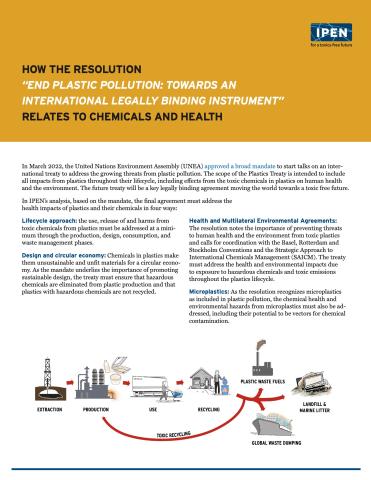How the Plastic Pollution Resolution relates to chemicals and health

In March 2022, the United Nations Environment Assembly (UNEA) approved a broad mandate to start talks on an international treaty to address the growing threats from plastic pollution. The scope of the Plastics Treaty is intended to include all impacts from plastics throughout their lifecycle, including effects from the toxic chemicals in plastics on human health and the environment. The future treaty will be a key legally binding agreement moving the world towards a toxic free future.
In IPEN’s analysis, based on the mandate, the final agreement must address the health impacts of plastics and their chemicals in four ways:
Lifecycle approach: the use, release of and harms from toxic chemicals from plastics must be addressed at a minimum through the production, design, consumption, and waste management phases.
Design and circular economy: Chemicals in plastics make them unsustainable and unfit materials for a circular economy. As the mandate underlies the importance of promoting sustainable design, the treaty must ensure that hazardous chemicals are eliminated from plastic production and that plastics with hazardous chemicals are not recycled.
Health and Multilateral Environmental Agreements: The resolution notes the importance of preventing threats to human health and the environment from toxic plastics and calls for coordination with the Basel, Rotterdam and Stockholm Conventions and the Strategic Approach to International Chemicals Management (SAICM). The treaty must address the health and environmental impacts due to exposure to hazardous chemicals and toxic emissions throughout the plastics lifecycle.
Microplastics: As the resolution recognizes microplastics as included in plastic pollution, the chemical health and environmental hazards from microplastics must also be addressed, including their potential to be vectors for chemical contamination.
The fifth United Nations Environmental Assembly (UNEA5) decided that negotiations will be starting in 2022 for a legally binding agreement on plastic pollution. The International Negotiation Committee (INC) will have a broad mandate to address plastic pollution in all its aspects and impacting all environments. While the terms chemicals, additives, hazard, or toxic do not appear in the final text, the chemical content, and the toxic impacts of plastics on human health and on the environment are clearly included in the mandate. The future treaty will be a key instrument in advancing the world towards a toxic-free future.
Lifecycle approach
The resolution recognizes that plastic pollution needs to be tackled through a full lifecycle approach and the operative part of the resolution specifically requires that the legally binding instrument to be developed should have a comprehensive approach that addresses the full lifecycle of plastics. This means that the use and release of harmful substances will be addressed at all phases of the lifecycle of plastics. As a minimum the toxic impacts of plastics during production, design, consumption, and waste management will be addressed in the treaty negotiations.
Design and circular economy
The resolution underlines the importance of promoting sustainable design of products and materials so that they can be reused, remanufactured, or recycled and therefore retained in the economy for as long as possible. It specifically refers to the objective to “promote sustainable production and consumption of plastics, including, among others, product design, and environmentally sound waste management, including through resource efficiency and circular economy approaches”. Plastic design, their sustainable production and consumption means that the role of chemicals will have to be addressed. Circular economy principles acknowledge that plastics should be free of hazardous chemicals and proposed sustainability principles for plastics suggest that the use of hazardous substances is minimized. The treaty will have to ensure that hazardous chemicals are eliminated from plastic production and that plastics contaminated with hazardous chemicals cannot be recycled.
Health and MEAs
The resolution acknowledges the importance of preventing plastic pollution and its related risks to human health and adverse effects on human well-being and the environment. The resolution underlines that these objectives need to be achieved through cooperation and coordination with other instruments including the Basel, Rotterdam and Stockholm Conventions and the Strategic Approach to International Chemicals Management (SAICM). This means that future work needs to address the health impacts of plastics, including the impacts due to exposure to hazardous chemicals and toxic emissions throughout the lifecycle. This will provide space for accelerating the implementation of an international agreement that could help prevent the health impacts of plastics and of plastic waste contaminated with toxic chemicals.
Microplastics
The resolution recognizes that plastic pollution includes microplastics. This means that it is acknowledged that the issue of plastic pollution is broader than its physical impacts due to plastic litter and the issue of microplastics will also have to be tackled, including the chemicals dimension of it. The resolution also refers to the need for a science-to-policy mechanism to better understand the impacts of plastic pollution, which will be a tool to include the yet unrecognized chemical impacts of plastics and microplastics. Additionally, UNEA Resolution 2/11 already stated that “more research is needed on marine plastic debris and microplastics, including associated chemicals, and especially on environmental and social impacts – including on human health – and on pathways, fluxes and fate, including fragmentation and degradation rates, in all marine compartments and especially in water bodies and sediment deposits of the coastal and open ocean, as well as on impacts on fisheries, aquaculture and economy”. This means that the Treaty could recognize the emerging risks of microplastics, including their potential to be vectors for chemical contaminants.
Click the link below for this text and the text of the resolution
